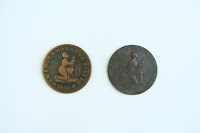 |
| Private collection, Tomilson Lake Hike to Freedom |
The coins currently on exhibit in the Fredericton Region Museum are on loan from Joe Gee, Vice-President of the New Brunswick Black History Society. They were acquired through purchase online in 2017.
History:
18th century Britain operated largely under the forced removal and exploitation of African people. Arguments made in favour of slavery were backed by pseudoscience or theology, and it wasn’t until the second half of the 18th century that there was a paradigm shift toward widespread anti slavery sentiment. Religious minorities (Unitarian, Baptist, Quaker, Methodist) powered by enlightenment philosophy were vocally opposed to slavery. Josiah Wedgwood himself was a Unitarian and believed, like many others, that “men as a social being depends on his living in a thriving community, state—depended on the liberty of all its members, whatever their class, creed, or colour.” This was the widely shared belief system that allowed the production and distribution of the coin to skyrocket.
Wedgwood was well respected and well known in his community as something of a philanthropist. As a Unitarian he opposed slavery and wanted to actively participate in the anti-slavery movement. In 1787 he decided to join the Society for Effecting the Abolition of the Slave Trade, a British abolitionist group dedicated to exposing the realities and horrors of the slave trade to the public. As the owner of a sizable pottery company and a prominent businessman, Josiah Wedgwood was very busy. Because he couldn’t dedicate much time to the hands-on work of the Society, he decided to produce the medallions as his way of contributing to the cause.
Henry Weber, a member of the Society and a modeler at Wedgwood's factory was tasked with the design and craftsmanship behind the coin. He made many prototypes, all of which were voted on by the Society. The final design and the one we know today was chosen by Josiah Wedgwood, as was the inscription on the coin; “Am I Not a Man And a Brother.” A popular phrase used in Enlightenment Philosophy.
Society for Effecting the Abolition of the Slave Trade
The Society for Effecting the Abolition of the Slave Trade was a British abolitionist group formed in 1787 by twelve men in London, England. It was largely made up of wealthy businessmen Quaker businessmen. Three Anglicans also co-founded the Society, Thomas Clarkson, Granville Sharp, and Phillip Sansom. The Society worked to expose the truth to the public and garner support for the anti-slavery cause. They wrote books and poems, printed pamphlets and newsletters, and produced clay medallions and stamps. All of which attempted to draw awareness to their mission. They also held rallies and debates, some of which were attended by both men and women. Crowds would gather to hear them speak about the men, women, and children who were being denied freedom everyday by the forces of the British empire.
The Society succeeded in educating and recruiting members of the public, largely in part because of the general dissatisfaction with the way things were being run by their government. Abolition, on the other hand, did not succeed. At least not in a timely manner. Britain agreed to abolish the slave trade in 1807 and voted to gradually outlaw it across the nation and within British colonies.
Formal slavery continued until 1838 when slaves in all British colonies were freed. Even so, men and women were forced to perform hard labour and were placed in unfair living conditions. Slavery just changed its mask and its name and continued to operate under another guise for decades.
Coins in the United States
As part of the Society's mission to educate the public about the harsh realities of the slave trade, Wedgwood shipped packages of medallions and accompanying pamphlets to Thomas Clarkson and Benjamin Franklin (then President of the Philadelphia Society for the Abolition of Slavery) in the United States.
Later, the American abolitionist movement adopted the symbol and slogan for their own use.
Am I Not a Woman and a Sister: Women and the Anti Slavery Campaign
The emblem displayed on this medallion was also adopted by women who took up arms in the movement, echoing the sentiment of the Society for the Abolition of Slavery. In the 1830’s it was used on printed matter and artifacts that were associated with women-only anti-slavery associations.
Their involvement in the Society was minimal at first. Like anyone else, they could pay to subscribe to the monthly newsletter and contribute to the cause in the form of donations. The names of all of the donors to the Society were listed at the end of the newsletter in a public subscriber list. There is a record of 206 female members which comprises 10% of the total number of Society members. This public marker is a large contributor to our knowledge base about women’s involvement in the anti-slavery movement of the 18th century.
Women had limited participation in the physical realm of the movement and were barred from signing petitions, as it was widely believed their names would diminish the value of the document. Petitions created by Thomas Clarkson were among those that didn’t allow women to sign. Beginning in the 1780’s women could participate in some public debates about the slave trade if they wore veils to cover their face. It was also around this time that women began to boycott products produced under slavery. As the ones purchasing goods, women stopped buying West Indian sugar and rum and encouraged other women to switch to products produced under fair labour conditions.
Sources:
Guyatt, M. “The Wedgwood Slave Medallion: Values in Eighteenth-Century Design.” Journal of Design History vol 13, no. 2 (2000): 93–105. https://doi.org/10.1093/jdh/13.2.93.
“Am I Not A Woman And A Sister: Women and the Anti-Slavery Campaign.” Woman and her Sphere, October 1, 2012. https://womanandhersphere.com/2012/10/01/am-i-not-a-woman-and-a-sister-women-and-the-anti-slavery-campaign/.
